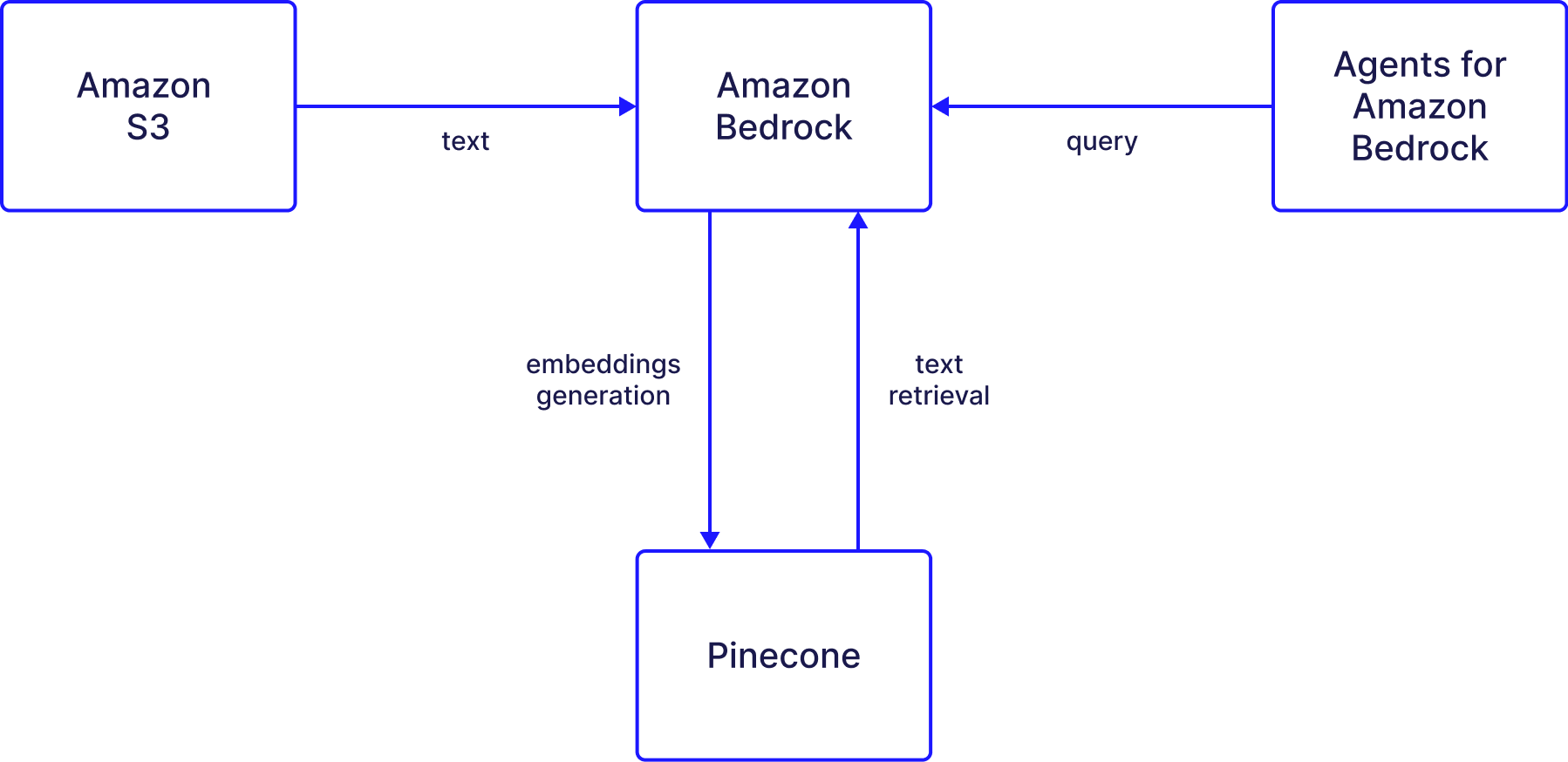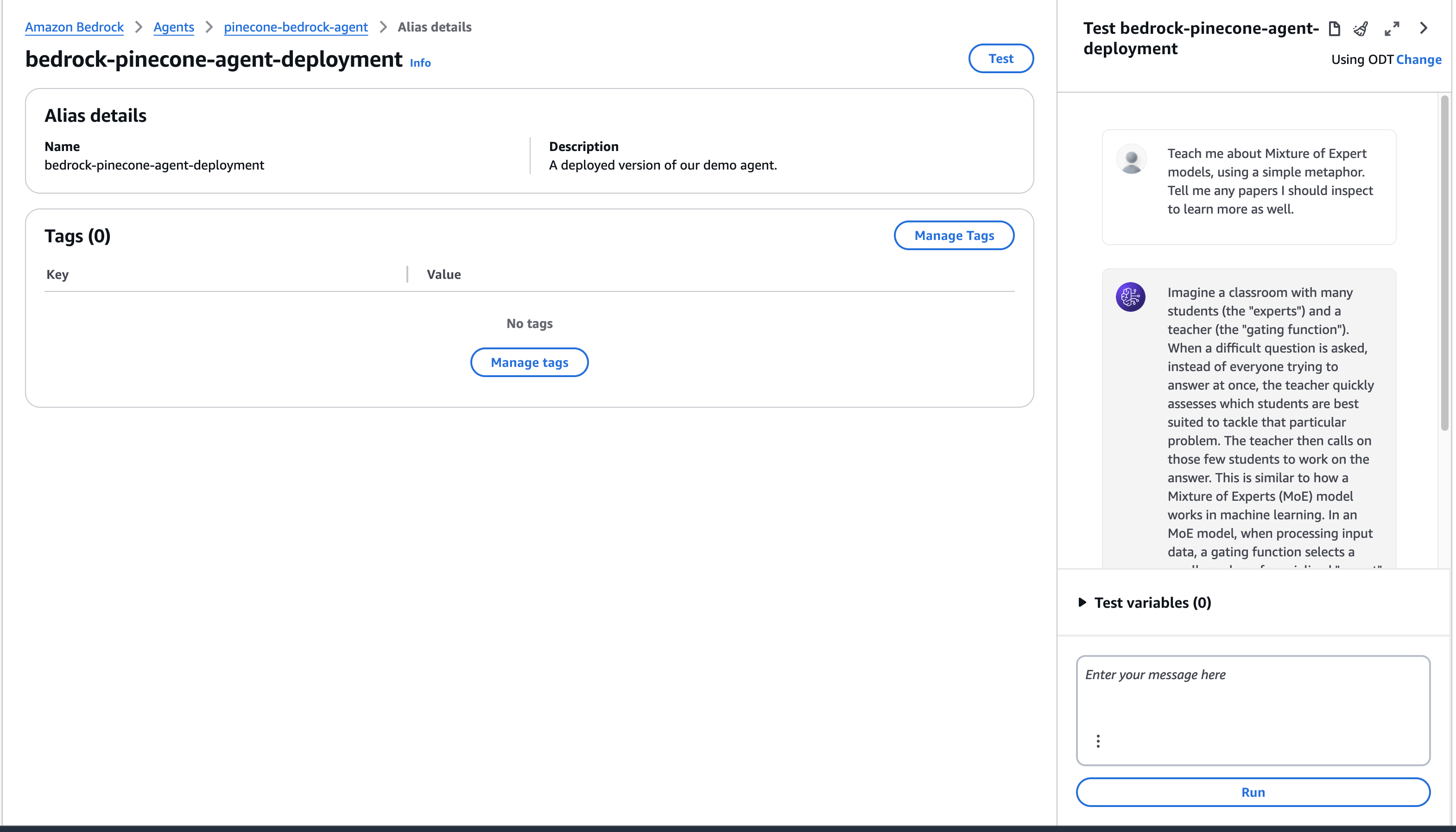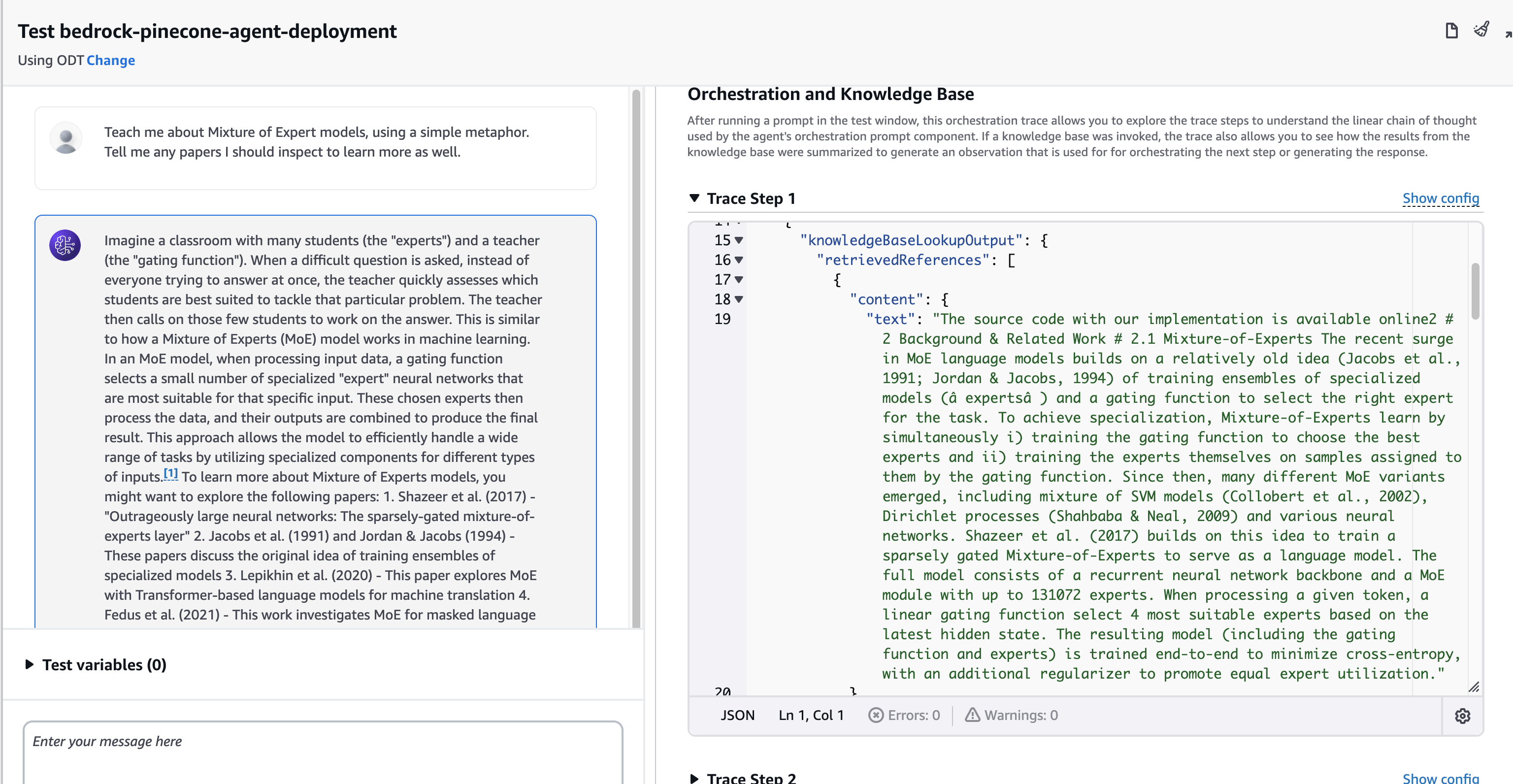- Highly performant: Speed through data in milliseconds. Leverage metadata filters and sparse-dense index support for top-notch relevance, ensuring quick, accurate, and grounded results across diverse search tasks.
- Cost effective at scale: Start for free on the starter plan and seamlessly scale usage with transparent usage-based pricing. Add or remove resources to meet your desired capacity and performance, upwards of billions of embeddings.
- Enterprise ready: Launch, use, and scale your AI solution without needing to maintain infrastructure, monitor services, or troubleshoot algorithms. Pinecone meets the security and operational requirements of enterprises.
What are Agents for Amazon Bedrock?
In Bedrock, users interact with Agents that are capable of combining the natural language interface of the supported LLMs with those of a Knowledge Base. Bedrock’s Knowledge Base feature uses the supported LLMs to generate embeddings from the original data source. These embeddings are stored in Pinecone, and the Pinecone index is used to retrieve semantically relevant content upon the user’s query to the agent. Note: the LLM used for embeddings may be different than the one used for the natural language generation. For example, you may choose to use Amazon Titan to generate embeddings and use Anthropic’s Claude to generate natural language responses. Additionally, Agents for Amazon Bedrock may be configured to execute various actions in the context of responding to a user’s query - but we won’t get into this functionality in this post.What is a Knowledge Base for Amazon Bedrock?
A Bedrock Knowledge base ingests raw text data or documents found in Amazon S3, embeds the content and upserts the embeddings into Pinecone. Then, a Bedrock agent can interact with the knowledge base to retrieve the most semantically relevant content given a user’s query. Overall, the Knowledge Base feature is a valuable tool for users who want to improve their AI models’ performance. With Bedrock’s LLMs and Pinecone, users can easily integrate their data from AWS storage solutions and enhance the accuracy and relevance of their AI models. In this post, we’ll go through the steps required for creating a Knowledge Base for Amazon Bedrock as well as an agent that will retrieve information from the knowledge base.
Setup guide
The process of using a Bedrock knowledge base with Pinecone works as follows:1
Create a Pinecone index.
Create an empty Pinecone index with an embedding model in mind. The index must be empty for Bedrock integration.
2
Set up a data source.
Upload sample data to Amazon S3.
3
Create a Bedrock knowledge base.
Sync data with Bedrock to create embeddings saved in Pinecone.
4
Connect Pinecone to Bedrock.
Use the knowledge base to reference the data saved in Pinecone.
5
Create and link agents to Bedrock.
Agents can interact directly with the Bedrock knowledge base, which will retrieve the semantically relevant content.
1. Create a Pinecone index
The knowledge base stores data in a Pinecone index. Decide which supported embedding model to use with Bedrock before you create the index, as your index’s dimensions will need to match the model’s. For example, the AWS Titan Text Embeddings V2 model can use dimension sizes 1024, 384, and 256. After signing up to Pinecone, follow the quickstart guide to create your Pinecone index and retrieve yourapiKey and index host from the Pinecone console.
Your index must have the same dimensions as the model you will later select for creating your embeddings. Also, your index must be empty. All data must be ingested through Bedrock’s sync process.
2. Set up your data source
Set up secrets
After setting up your Pinecone index, you’ll have to create a secret in AWS Secrets Manager:- In the Secret type section, select Other type of secret.
- In the Key/value pairs section, enter a key value pair for the Pinecone API key name and its respective value. For example, use
apiKeyand the API key value.
- Click Next.
- Enter a Secret name and Description.
- Click Next to save your key.
- On the Configure rotation page, select all the default options in the next screen, and click Next.
- Click Store.
- Click on the new secret you created and save the secret ARN for a later step.
Set up S3
The knowledge base is going to draw on data saved in S3. For this example, we use a sample of research papers obtained from a dataset. This data will be embedded and then saved in Pinecone.- Create a new general purpose bucket in Amazon S3.
-
Once the bucket is created, upload a CSV file.
The CSV file must have a field for text that will be embedded, and a field for metadata to upload with each embedded text.
-
Save your bucket’s address (
s3://…) for the following configuration steps.
3. Create a Bedrock knowledge base
To create a Bedrock knowledge base, use the following steps:- Enter a Knowledge Base name.
- In the Choose data source section, select Amazon S3.
- Click Next.
- On the Configure data source page, enter the S3 URI for the bucket you created.
- If you do not want to use the default chunking strategy, select a chunking strategy.
- Click Next.
4. Connect Pinecone to the knowledge base
Now you will need to select an embedding model to configure with Bedrock and configure the data sources.- Select the embedding model you decided on earlier.
- For the Vector database, select Choose a vector store you have created and select Pinecone.
-
Mark the check box for authorizing AWS to access your Pinecone index.
Ensure your Pinecone index is empty before proceeding. Bedrock cannot work with indexes that contain existing data. All data must be ingested through Bedrock’s sync process.
- For the Endpoint URL, enter the Pinecone index host retrieved from the Pinecone console.
- For the Credentials secret ARN, enter the secret ARN you created earlier.
-
In the Metadata field mapping section, enter the Text field name you want to embed and the Bedrock-managed metadata field name that will be used for metadata managed by Bedrock (e.g.,
metadata). - Click Next.
- Review your selections and complete the creation of the knowledge base.
- On the Knowledge Bases page select the knowledge base you just created to view its details.
-
Click Sync for the newly created data source.
Sync the data source whenever you add new data to the data source to start the ingestion workflow of converting your Amazon S3 data into vector embeddings and upserting the embeddings into the vector database. Depending on the amount of data, this whole workflow can take some time.
5. Create and link an agent to Bedrock
Lastly, create an agent that will use the knowledge base for retrieval:- Click Create Agent.
- Enter an Name and Description.
- Click Create.
- Select the LLM provider and model you’d like to use.
- Provide instructions for the agent. These will define what the agent is trying to accomplish.
- In the Knowledge Bases section, select the knowledge base you created.
- Prepare the agent by clicking Prepare near the top of the builder page.
- Test the agent after preparing it to verify it is using the knowledge base.
- Click Save and exit.
Create an alias for your agent
In order to deploy the agent, create an alias for it that points to a specific version of the agent. Once the alias is created, it will display in the agent view.- On the Agents page, select the agent you created.
- Click Create Alias.
- Enter an Alias name and Description.
- Click Create alias.
Test the Bedrock agent
To test the newly created agent, use the playground on the right of the screen when we open the agent. In this example, we used a dataset of research papers for our source data. We can ask a question about those papers and retrieve a detailed response, this time with the deployed version.
